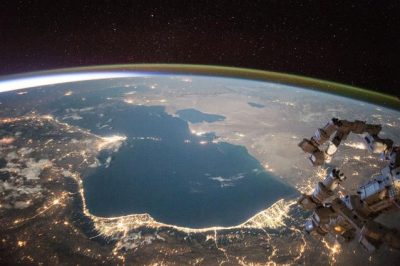The Caspian Sea Is Evaporating Due to Rising Average Temperatures
September 14, 2017

Credit: Scott Kelly/NASA-JSC.
When the ancient Romans arrived at the Caspian Sea a couple thousand years ago, they thought they’d arrived at an ocean. That’s because the water they encountered was salty. Nope! Sorry, Romans. Nestled amongst modern day Russia, Kazakhstan, Turkmenistan, Azerbaijan and Iran, the Caspian Sea actually is the world’s largest lake. Its waters are brackish — about a third as salty as most ocean water — because, though water finds its way into it from about 130 different freshwater sources, it has no outlet. If water is going to escape the Caspian Sea, it’s got to do it through evaporation.
So, it’s strange that the water level of the Caspian Sea has been steadily dropping for the past couple of decades. Between 1996 and 2015, the sea has been drawn down about 3 inches (7 cm) per year — about 5 feet (1.5 meters) total. This is not the first time water levels in the Caspian have dramatically dropped, mind you. Over the course of the 20th century, changes in agricultural practices in its basin, as well as industry and damming on the Volga River (which accounts for 80 percent of the inflow of water), pulled the sea down to 3 feet (1 meter) below what it is today by the late 1970s.
HowStuffWorks, Sept. 8, 2017
The Hindu, Sept. 1, 2017
ScienceAlert, Aug. 30, 2017
Deccan Herald, Sept. 14, 2017
DailyMail, Aug. 30, 2017
Featuring: Clark Wilson, Wallace E. Pratt Professor of Geophysics, Department of Geological Sciences, Jackson School of Geosciences
